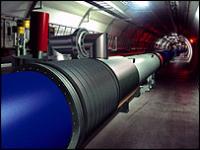







|
News and Information
Underground search for 'God particle'
| February 4, 2005 |
 News Front Page News Front Page
Africa
Americas
Asia-Pacific
Europe
Middle East
South Asia
UK
England
Northern Ireland
Scotland
Wales
Politics
Education
Magazine
Business
Health
Science/Nature
Technology
Entertainment
-----------------
Have Your Say
In Pictures
Week at a Glance
Country Profiles
In Depth
Programmes
By Paul Rincon
BBC News science reporter in Geneva, Switzerland
A circular tunnel runs for 27km under the French-Swiss border
Enlarge Image
At the foot of the Jura Mountains, where Switzerland meets France, is a laboratory so vast it boggles the mind.
But take a drive past the open fields, traditional chalets and petite new apartment blocks and you will look for it in vain.
To find this enormous complex, you have to travel beneath the surface.
One hundred metres below Geneva's western suburbs is a dimly lit tunnel that runs in a perfect circle for 27km (17 miles).
Nature is much smarter than us. It might come up with a real surprise and that would be much more interesting - much more satisfying
Professor Jim Virdee, Imperial College London
The tunnel belongs to Cern, the European Centre for Nuclear Research. Though currently empty, over the next two years an enormous experiment will be installed here.
The Large Hadron Collider (LHC) is a powerful and impossibly complicated machine that will smash particles together at super-fast speeds in a bid to unlock the secrets of the Universe.
'New physics'
By recreating the searing-hot conditions fractions of a second after the Big Bang, scientists hope to see new physics, discover the sought-after "God particle", uncover new dimensions and even generate mini-black holes.
When completed, two parallel tubes will carry high-energy particles called protons in opposite directions around the tunnel at close to the speed of light.
The tunnel's huge circumference provides only the slightest of bends. Nevertheless, 5,000 superconducting magnets are needed to steer and focus the particles around the tubes.
Along the way, they will pass through enormous experimental instruments called detectors where the proton beams will cross.
When some of these protons collide at high energy, smaller, heavier particles can appear amongst the debris.
Great quest
When the LHC is turned on in the latter half of 2007, physicists will scour this crash wreckage for signs of the Higgs boson.
The Higgs is nicknamed the God particle because of its importance to the Standard Model, the theory devised to explain how sub-atomic particles interact with each other.
The 16 particles that make up this model (12 matter particles and 4 force carrier particles) would have no mass if considered alone. So another particle - the Higgs boson - is postulated to exist to account for this omission.
The CMS is constructed from different layers in an "onion" structure
Enlarge Image
"The Standard Model is the best thing we've come up with so far," says Jim Virdee, spokesman for the team working on the Compact Muon Solenoid (CMS) detector.
But everyone recognises it is merely a stage on the way to something else. The Standard Model described ordinary matter and yet astronomical observations show this makes up but small part of the Universe.
Needless to say, new theories are gaining ground and discoveries at the LHC could lead physicists towards a unified theory to explain how the Universe works.
"We are at a stage where the theorists do not know which direction to go in. The results from [our] experiment will determine which direction science takes," says Professor Virdee, who is based at Imperial College London, UK.
"We don't always like theorists to tell us what we should find. Nature is much smarter than us.
"It might come up with a real surprise and that would be much more interesting - much more satisfying."
Huge scale
The detectors at the LHC will count, trace and analyse the particles that emerge from the collisions between protons.
To call them experiments simply does not give an idea of their scale. The equipment weighs tens of thousands of tonnes and in some cases is as tall as a multi-storey building.
A giant cavern will house the CMS detector at Cern
Enlarge Image
This week marked the inauguration of the enormous cavern at Meyrin in France that will house CMS (Compact Muon Solenoid). A 78m-long shaft leads up to the surface, through which the CMS will be lowered by crane early next year.
Both the CMS and its rival experiment, Atlas, are based on a cylindrical "onion" structure with several layers to perform different roles.
By 2010, nearly one billion collisions will take place every second in these detectors.
"CMS needs to collect a sample of several hundred collisions out of 40 million. And we have just three milliseconds to decide whether a collision produced something interesting," Professor Virdee told the BBC News website.
High energy
After attending the CMS inauguration, we travelled just across the border to Switzerland, where the Atlas cavern is located.
Measuring 53m long, 30m wide and 35m high, it is big enough to house Canterbury Cathedral and is currently empty but for the support structures that will hold the detector in place.
The Atlas cavern could fit a 12-storey building inside it
Enlarge Image
"You're visiting at a good time. It won't look like this again," says Atlas technical co-ordinator Mark Hatch.
High radiation levels when the LHC is running mean access to these caverns will be forbidden when the machine is in operation, creating problems for the scientists.
The energies achieved by the experiment are 70 times greater than those of the Large Electron-Positron Collider (LEP) which previously occupied the tunnels at Cern.
Only by raising the bar will scientists be able to expand our current understanding of the Universe.
Whatever the discoveries ahead for physicists working at the LHC, the experiments will, according to its chief scientific officer Jos Engelen, "keep physicists off street corners for a long time to come". |
Source: www.bbc.com |
| http://news.bbc.co.uk/2/hi/uk_news/4229545.stm |
|
| Support Caprivi Freedom |
Fill out the form below to become a member of this site and receive our regular newsletter.
|

|

